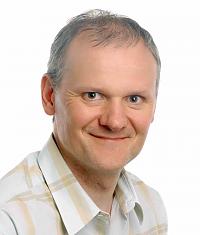
Professor Steve Charnock-Jones
Position: Professor
Personal home page:
http://www.obgyn.cam.ac.uk/steve.html
PubMed journal articles - click here
Professor Steve Charnock-Jones is pleased to consider applications from prospective PhD students.
My cancer related research is focused on the molecular mechanisms underlying the progression from endometriosis to clear cell ovarian cancer. Endometriosis is a relatively common condition affecting approximately 10% of women of child bearing age and it is known from epidemiological studies that in a small proportion of these cases there is an increased incidence of clear cell ovarian cancer. Recent work has shown that mutations in Arid1a gene are strongly associated with clear cell ovarian cancer and my work focuses on determining the role of this gene in endometriosis and its possible progression to clear cell carcinoma. To that end, we use a model of murine endometriosis which we developed which we are using to test the effects of Arid1a ablation. We also carry out work using human tissues in vitro, in vivo and in retrospective genetics studies. I have other work focused on endothelial cell biology but with particular relevance to the behaviour and function of these cells in the reproductive tract. The female reproductive tract and the placenta provide physiological systems in which angiogenesis occurs on a regular basis. Understanding how this process is controlled under normal conditions gives insight into the basic biological mechanisms underlying angiogenesis which may be perturbed under pathological conditions and are also open to therapeutic intervention. Endothelial cells are also a critical part of the placenta and the way this tissue responds to oxidative stress during pregnancy is also of considerable interest. My work focuses on the molecular mechanisms underlying the behaviour of these cells and I use a range of techniques including gene array analysis, RNAi-mediated knock-down, cellular and in vivo models. My work on understanding and manipulating angiogenesis is of direct relevance to solid tumour growth.
Symplectic Elements feed provided by Research Information, University of Cambridge
Cheng, Ching-Wen, Diana Licence, Emma Cook, Feijun Luo, Mark J Arends, Stephen K Smith, Cristin G Print, and D Stephen Charnock-Jones. 2011. Activation of Mutated K-Ras in Donor Endometrial Epithelium and Stroma Promotes Lesion Growth in an Intact Immunocompetent Murine Model of Endometriosis. The Journal of Pathology 224 (2) (June 1): 261?269. doi:10.1002/path.2852. Gounaris, Ioannis, D Stephen Charnock-Jones, and James D Brenton. 2011. Ovarian Clear Cell Carcinoma--Bad Endometriosis or Bad Endometrium? The Journal of Pathology 225 (2): 157?160. doi:10.1002/path.2970. Yung, Hong-wa, Myriam Hemberger, Erica D Watson, Claire E Senner, Carolyn P Jones, Randal J Kaufman, D Stephen Charnock-Jones, and Graham J Burton. 2012. Endoplasmic Reticulum Stress Disrupts Placental Morphogenesis: Implications for Human Intrauterine Growth Restriction. The Journal of Pathology doi:10.1002/path.4068. Saidi, Samir A, Cathrine M Holland, D Stephen Charnock-Jones, and Stephen K Smith. 2006. ?In Vitro and in Vivo Effects of the PPAR-Alpha Agonists Fenofibrate and Retinoic Acid in Endometrial Cancer. Molecular Cancer 5: 13. doi:10.1186/1476-4598-5-13. Saidi, Samir A, Cathrine M Holland, David P Kreil, David J C MacKay, D Stephen Charnock-Jones, Cristin G Print, and Stephen K Smith. 2004. Independent Component Analysis of Microarray Data in the Study of Endometrial Cancer. Oncogene 23 (39) (August 26): 6677?6683. doi:10.1038/sj.onc.1207562. Sowter, H M, A N Corps, A L Evans, D E Clark, D S Charnock-Jones, and smith sS K. 1997. Expression and Localization of the Vascular Endothelial Growth Factor Family in Ovarian Epithelial Tumors. Laboratory Investigation; a Journal of Technical Methods and Pathology 77 607?614.















